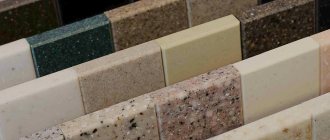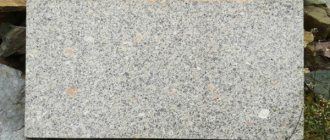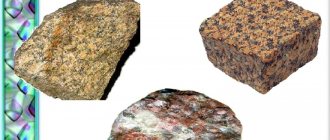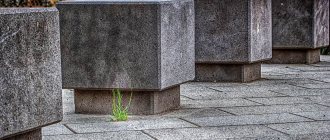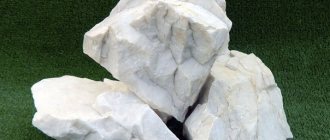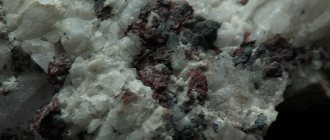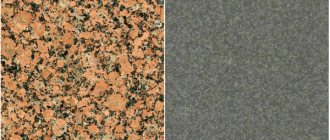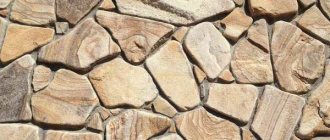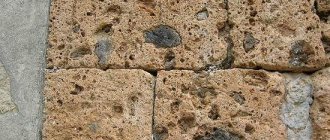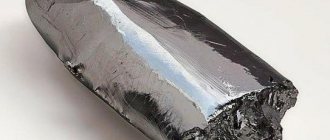The formation of granite and faceted soil in general is still not fully understood. The strength of the rock is such that just 1 cm² of it can withstand a 600 kg load without consequences. This is 2600 kg/m³.
The formation of granite and faceted soil in general is still not fully understood
The amazing hardness of granite is up to 7 on the Mohs mineralogical scale. This hardness scale has 10 divisions and uses the scratch method. The density of granite is impressive: 1 cm³ weighs 3 times more than the same volume of water.
It cannot be said that all the physical properties of granite are impeccable. While withstanding temperature changes that are insane for humans of 100 degrees or more, it cannot boast of the same excellent refractoriness and melts when heated to 700 °C.
The low melting point of granite is the main reason why many ancient structures did not survive fires and were irretrievably lost.
We also recommend reading:
The history and curse of the Kohinoor stone The marvelous ametrine stone Characteristics of larimar and its main properties Selection of stones by date of birth
Given this feature, subsequent generations of builders and architects still prefer to use all types of granite as a facing material. Frost-resistant, with a water- and dirt-repellent surface, it has a favorable price among materials for similar purposes.
Rock composition
What is this breed made of? The mineral composition of granite is based on minerals formed during the crystallization of magma, such as plagioclase, potassium feldspar, quartz, and mica. Granite derives its composition from igneous plutonic rocks of high acidity. The basis of the earth's crust, its most important rock, is granite stone. However, how such minerals are formed is still not completely clear. There is an assumption that during the crystallization process, basaltic magma is gradually saturated with various chemical elements. Moreover, this process is subject to a certain pattern. At the end of this complex and long path, differentiates are formed - derivatives of a certain basaltic melt. The chemical composition of granite indirectly indicates the veracity of this assumption. After all, the rock is saturated with fusible sodium, potassium, and silicon.
The basis of the earth's crust, its most important rock, is granite stone
Stone has many faces. Its structure may be different. It can be fine-, medium- and coarse-grained. The finer the grain fraction (from 2 mm), the stronger the rock, the less susceptible it is to various atmospheric phenomena.
History and origin
One lyricist in his poems associated granite with the words “edge” and “boundaries”, but the name of the stone arose from the Latin granum - “grain” . The name of the mineral was given by the Italian naturalist Caesalpinus. But the first information about the rock itself was recorded in documents from the times of Ancient Egypt and Rome. Then people used the material in the construction of fundamental structures.
Granite is often associated with strength and reliability. It makes up most of the earth's crust. There are even entire mountains made from this rock, for example, Mont Blanc. The stone is called the “calling card of the Earth” because it is not found on other planets.
Scientists give two versions of the origin of granite. Some experts believe that natural stone arose from molten magma, which slowly cooled in the earth's crust. Over time, it formed into a fossilized structure, and over many years, granite grains of various sizes crystallized in it.
Other scientists are inclined to believe that sedimentary rocks with sand and types of clay gradually shifted due to tectonic processes deep in the earth's crust. High temperatures and pressure caused the substances to melt. This process was called granitization.
Most of the world's granites are formed in collision zones. When two continental plates collide with each other, the layer of crust on the continent increases. Due to thickening, layered deposits of molten rock appear at a depth of 10−20 km. This phenomenon is called granitic magmatism.
Color variations
Varieties of granite find different applications in areas of human activity. In many ways, color is decisive. It can be red, black, gray, beige, brown, bluish and even pink. Quartz and mica fragments in the composition give the stone, illuminated by the sun or artificial light, a sparkling appearance.
Granite gets its colors from the feldspars it contains.
Pink granite is also called amethyst for its shades from delicate to deep purple. Its deposits on Russian territory are in Karelia. And in Brittany there is Pleneuf-Val-André, the coast of which is called the Coast of Pink Granite for the unique delicate color of the boulders.
Varieties of granite find different applications in areas of human activity
Rich red slabs can be found in the decoration of buildings, bridges and embankments.
If the composition of the rock is dominated by black quartz, then the color of the granite is black. This variation is in great demand when constructing monuments, along with marble. Solemnly austere and at the same time radiating brilliance, such a stone looks stunning both in the form of a stele and as part of a composite monument. Green color is rare. Gray is the most common in construction.
Other varieties
There are many classifications of stone according to different criteria. Based on the nature and content of dark-colored inclusions, granite is divided into the following types:
- Alaska. Does not contain dark inclusions.
- Biotite. The volume of biotite in the mineral varies between 6−8%.
- Leucogranite. Low level of dark-colored particles.
- Double mica. Such minerals include biotite and muscovite.
- Lithium fluoride. The stone contains lithium micas.
- Pyroxene. The composition contains augite, quartz and orthoclase.
- Alkaline. Characterized by the presence of alkaline components.
Granite is also classified according to its grain structure. Porphyry-like stone is distinguished by brightly defined long inserts that protrude from the main mass of the rock. Pegmatoid granite is characterized by a symmetrical and uniform grain pattern. Finnish rapakivi stone is characterized by rounded inserts with a gray or greenish frame. The gneiss-like mineral has a fine-grained structure.
Stone of the Amazons
Amazonite granite among others looks magical. Its greenish-emerald hue looks perfect in jewelry boxes, snuff boxes, ashtrays and even beads embodied in stone.
The first deposit of this rock was discovered in Mongolia. But earlier it was also found in Scythian burial mounds in the form of jewelry, household items and even weapons. Herodotus and Pliny also associated this interesting name of the stone with the militant Amazons (from the Greek “amazon” - breastless).
The works of ancient scientists contain a description of these women who, worshiping the goddess of fertility, sacrificed their breasts to her. One of the legends puts forward the version that the use of granite by the Amazons made it possible to do without the brutal amputation of the right breast. Instead, warriors rubbed it with green amazonite powder from childhood. This, of course, is just a beautiful version, but it is not without scientific background.
The breed comes in shades from green to almost blue. This is a beautiful finishing and ornamental material.
Traces of tantalum and tin are often found in its composition. It is found on the Kola Peninsula and the Urals. Other mining sites are Madagascar's Antananarivo and Zimbabwe.
Physical properties
One of the most important properties of granite is its strength. The smaller the grain size in the stone, the higher this indicator. This mineral is twice as strong as marble.
The stone is divided into three groups:
- Fine-grained. The grain size is less than 2 mm. Such minerals are characterized by a high degree of strength, resistance to destruction and water resistance. They are considered the most expensive and in demand due to their high quality.
- Medium grain. The grain size varies between 2−5 mm. The characteristics of this type are slightly worse than the previous one, but it is also often used in construction.
- Coarse-grained. Grains exceeding 5 mm make the material less fire resistant. At temperatures above 600 °C the stone is damaged and increases in volume.
The density of the rock is 2600 kg/m3, Mohs hardness is 5-7. Melting point - 1215−1260°C; in the presence of water and pressure it can drop to 650 °C. The average specific gravity of stone is 2700−3000 kg/m2. Granite is characterized by low water absorption and low abrasion coefficient. The stone is quite easy to process and polish , after which it retains its mirror surface for a long period. The mineral can also be carved. It can be given any shape.
The stone retains its characteristics even in the harshest environmental conditions. Granite is considered an environmentally friendly and ergonomic material. Any variety of this rock is safe for people and animals. Rock does not emit radiation. There are no restrictions on the use of granite in construction work.
Some types of stone can be given a decorative texture only after heat treatment. This is usually necessary for materials of light gray shades, which after finishing work become almost sugar-white.
Artificial or natural
Despite widespread mining, the properties and uses of natural granite do not always satisfy the goals of the end consumer.
And price is not always the deciding factor. Although she is not small. Artificial granite successfully solves problems that are difficult for natural granite. Products made from it look amazing.
It is difficult to call a stone unnatural: consisting of 80% natural granite chips, it is even outwardly indistinguishable from natural stone.
The characteristics of artificial granite differ little from the characteristics of natural stone. But the price differs noticeably.
The main advantage is the ability to form almost any shape specified by human imagination, because granite is formed from a viscous mass.
Its properties are somewhat inferior to the natural mineral. But a lot depends on the quality of the components and the integrity of the manufacturer.
It is sometimes difficult to distinguish between materials created by nature and man-made. There is only one characteristic of granite that will help you do this. Tap the surface with a metal object: if it is natural, the sound will be loud, and if not, it will be muffled.
Karelian granite
Karelia is also a rich region for high-quality granite stone. More than 10 large deposits are being developed in Karelia, the most famous are Dymovskoye, Vinga, Kupetskoye, Elizovskoye, Sopka Buntina. Red-pink and dark colors of the stone predominate. There is also a Gabbro-Diabase deposit, the raw materials of which are in demand for the manufacture of ritual products. This stone does not change its appearance for decades and looks good at any time of the year.
Karelian granite is well suited for most applications of this natural stone: it is used to pave squares, used in urban design, and used for exterior cladding of commercial buildings. It is used to make paving stones, small architectural forms, and decorative elements. They make monuments, memorial slabs, tiles and parapets.
How to determine quality
A brief description of a stone is usually not complete without mentioning possible cracks. But are they a marriage? Whatever the color of the minerals, the strength and durability of granite are determined by nature itself.
The ability to repel water and resistance to pollution, as well as numerous granite historical and architectural monuments with a history of several hundred years, allow us to assert that no minor natural defects in stones can affect their performance properties. The service life of granite products can reach up to 500 years.
The opinion about the radiation background of the rock, which can harm human health, is biased. The level of its radiation does not exceed the permissible level. Granites are quite meltable. But hot kitchen utensils will never melt or damage a window sill or countertop made from this stone.
The stone is processed according to one or another scheme, depending on the purpose of the final product. It is sawed, polished, ground, polished. Products are even made from cut granite.
Burching produces a grainy texture with an anti-slip effect. Imitation of natural chipping is widely used in the production of monuments.
Ural granite
One of the largest concentrations of granite ore deposits is located in the Urals. Development is carried out from more than 12 mines, the most famous of which are Tashmurunsky, Mansurovsky, Sanarsky, Yuzhno-Sultaevsky, Malyshevsky, Sosnovy Bor and Tsvetok Ural. The age of the mined rocks is about 2.5 million years.
Most Ural granite rocks are gray and light gray in color. The exception is the Malyshevsky, Yuzhno-Sultaevsky and Zapadno-Sultaevsky granites, which have red and pink colors. The lightest of all Ural rocks is Mansurovskaya. The Ural deposits of granite stone are famous for their low, almost zero radioactivity, which allows the material to be used everywhere. Iron content varies from mine to mine - this must be taken into account when choosing a particular material for a specific purpose.
Ural granite has a relatively low cost, which allows it to be used even in road construction. They often decorate premises, building facades, make architectural forms, monuments and decorative elements.
Creating a Sketch
Many people underestimate the process of creating a sketch. But for high-quality drawing of stone step by step, it plays a key role. Thanks to it you can create a realistic drawing.
- The sketch is created on some basis. The best option is to go out into nature with little students.
- They will be able to draw from real life, improve their health and get a lot of positive emotions.
- To begin with, a few sketches are made. Gradually, a realistic stone is formed from them.
Tip: It is worth studying the techniques of famous artists. The child will be interested to learn how recognized artists create shadows or play with light.
